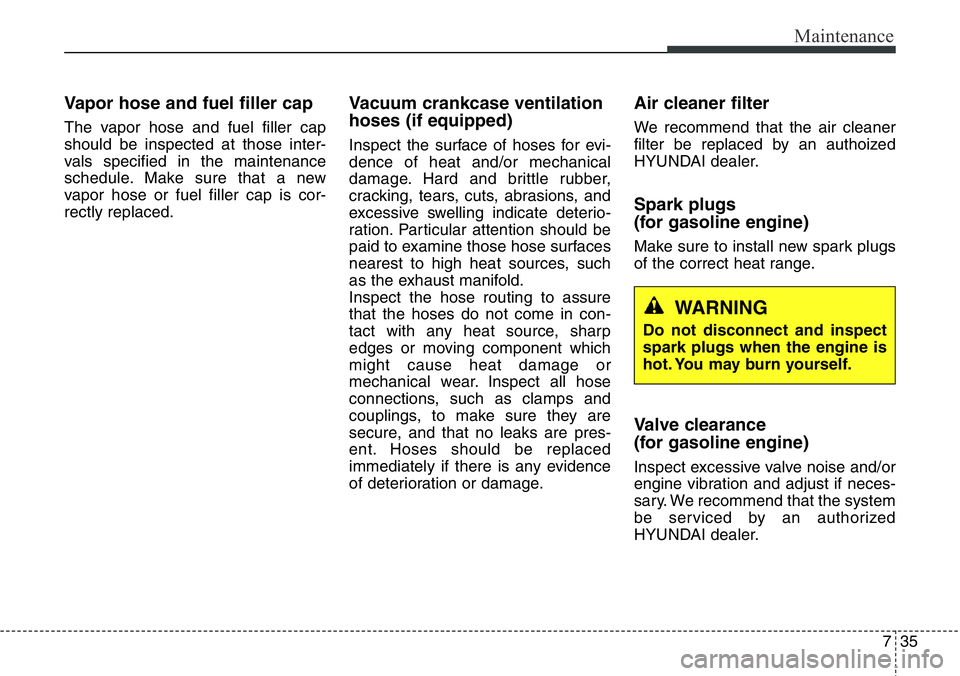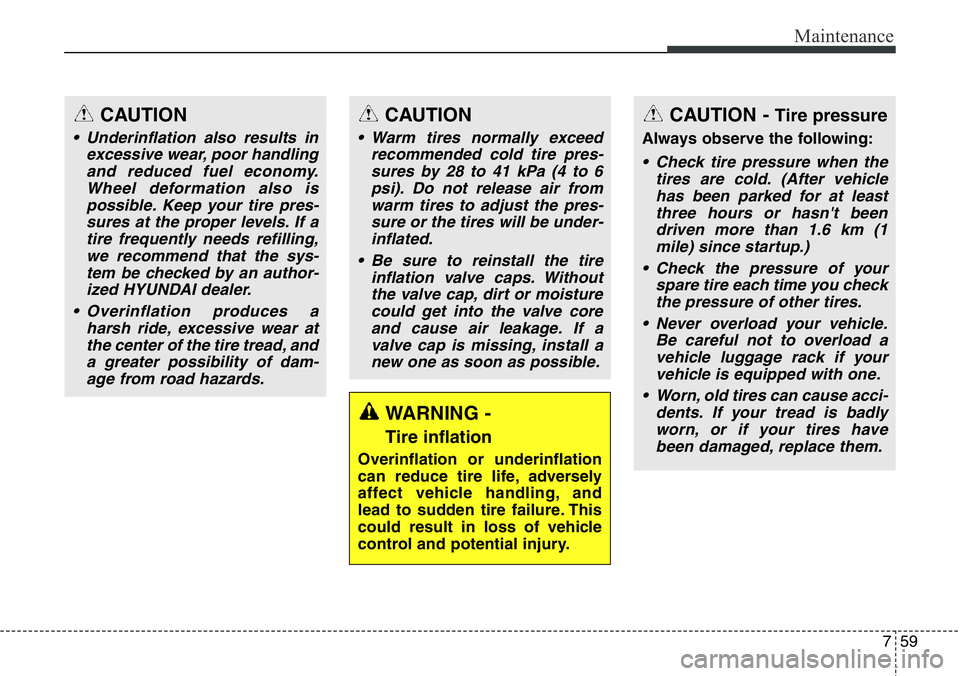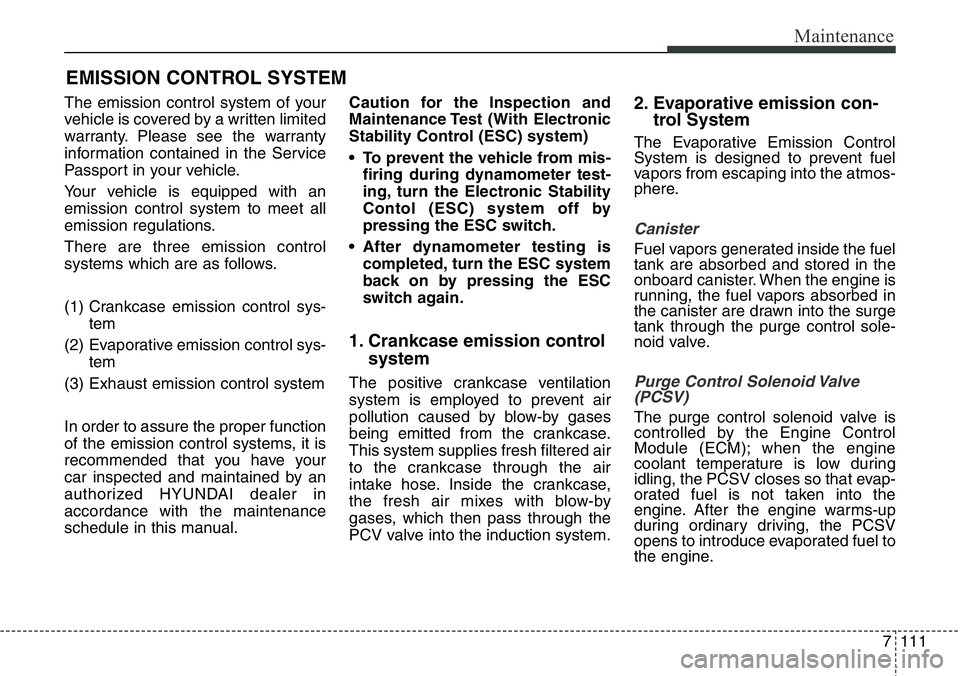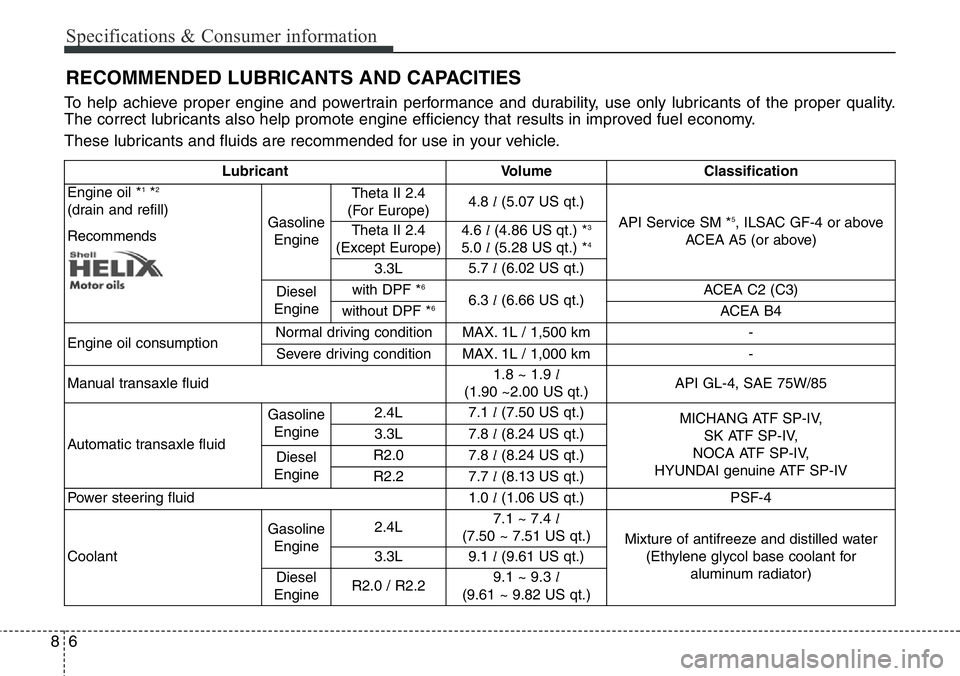Page 615 of 711

Maintenance
30 7
NORMAL MAINTENANCE SCHEDULE - EXCEPT EUROPE, FOR RUSSIA (CONT.)
120,000 km (80,000 miles) or 96months
❑ Inspect air cleaner filter
(for Except China, India, Middle East)
❑ Inspect air conditioner refrigerant/compressor (if equipped)
❑ Inspect battery condition
❑ Inspect brake lines, hoses and connections
❑ Inspect all electrical system
❑ Inspect brake/clutch(if equipped) fluid
❑ Inspect disc brakes and pads
❑ Inspect drive belt (Gasoline) *
1
❑ Inspect drive shafts and boots
❑ Inspect exhaust system
❑ Inspect front suspension ball joints
❑ Inspect fuel lines, hoses and connections
(Gasoline, Diesel)
❑ Inspect parking brake (Foot/Hand type)
❑ Inspect power steering fluid and hoses (if equipped)
❑ Inspect steering gear rack, linkage and boots
❑ Inspect tire (pressure & tread wear)
❑ Inspect transfer case oil (4WD) *
11
❑ Inspect rear differential oil (4WD) *11
❑ Inspect manual transaxle fluid (if equipped) *11
(Continued)
(Continued)
❑ Inspect vapor hose and fuel filler cap
❑ Inspect propeller shaft (if equipped)
❑ Inspect vacuum hose (for EGR & throttle body) (Gasoline)
❑ Replace air cleaner filter (for China, India, Middle East)
❑ Replace climate control air filter
❑ Replace engine oil and filter (Gasoline - MPI)
- Except Middle East *
2
❑ Replace engine oil and filter (Gasoline - MPI)
- For Middle East *2
(Every 10,000 km (6,500 miles) or 12months*3)
❑ Replace engine oil and filter (Gasoline - GDI) *2
- For China
(Every 5,000 km (3,100 miles) or 6months)
❑ Replace engine oil and filter (Diesel) - For Russia *
2*3
❑ Replace engine oil and filter (Diesel) - Except Russia *2*3
(Every 10,000 km (6,500 miles) or 12months)
❑ Replace fuel filter (Gasoline) *7
❑ Replace fuel filter cartridge (Diesel) *4
❑ Replace fuel tank air filter (Gasoline, if equipped)
❑ Replace spark plugs (Gasoline 2.4/3.3L - Iridium) *5
(Every 160,000 km (100,000 miles) or 120months)
(Continued)
Page 620 of 711

735
Maintenance
Vapor hose and fuel filler cap
The vapor hose and fuel filler cap
should be inspected at those inter-
vals specified in the maintenance
schedule. Make sure that a new
vapor hose or fuel filler cap is cor-
rectly replaced.
Vacuum crankcase ventilation
hoses (if equipped)
Inspect the surface of hoses for evi-
dence of heat and/or mechanical
damage. Hard and brittle rubber,
cracking, tears, cuts, abrasions, and
excessive swelling indicate deterio-
ration. Particular attention should be
paid to examine those hose surfaces
nearest to high heat sources, such
as the exhaust manifold.
Inspect the hose routing to assure
that the hoses do not come in con-
tact with any heat source, sharp
edges or moving component which
might cause heat damage or
mechanical wear. Inspect all hose
connections, such as clamps and
couplings, to make sure they are
secure, and that no leaks are pres-
ent. Hoses should be replaced
immediately if there is any evidence
of deterioration or damage.
Air cleaner filter
We recommend that the air cleaner
filter be replaced by an authoized
HYUNDAI dealer.
Spark plugs
(for gasoline engine)
Make sure to install new spark plugs
of the correct heat range.
Valve clearance
(for gasoline engine)
Inspect excessive valve noise and/or
engine vibration and adjust if neces-
sary. We recommend that the system
be serviced by an authorized
HYUNDAI dealer.
WARNING
Do not disconnect and inspect
spark plugs when the engine is
hot. You may burn yourself.
Page 644 of 711

759
Maintenance
WARNING -
Tire inflation
Overinflation or underinflation
can reduce tire life, adversely
affect vehicle handling, and
lead to sudden tire failure. This
could result in loss of vehicle
control and potential injury.
CAUTION - Tire pressure
Always observe the following:
• Check tire pressure when the
tires are cold. (After vehicle
has been parked for at least
three hours or hasn't been
driven more than 1.6 km (1
mile) since startup.)
• Check the pressure of your
spare tire each time you check
the pressure of other tires.
• Never overload your vehicle.
Be careful not to overload a
vehicle luggage rack if your
vehicle is equipped with one.
• Worn, old tires can cause acci-
dents. If your tread is badly
worn, or if your tires have
been damaged, replace them.
CAUTION
• Underinflation also results in
excessive wear, poor handling
and reduced fuel economy.
Wheel deformation also is
possible. Keep your tire pres-
sures at the proper levels. If a
tire frequently needs refilling,
we recommend that the sys-
tem be checked by an author-
ized HYUNDAI dealer.
• Overinflation produces a
harsh ride, excessive wear at
the center of the tire tread, and
a greater possibility of dam-
age from road hazards.
CAUTION
• Warm tires normally exceed
recommended cold tire pres-
sures by 28 to 41 kPa (4 to 6
psi). Do not release air from
warm tires to adjust the pres-
sure or the tires will be under-
inflated.
• Be sure to reinstall the tire
inflation valve caps. Without
the valve cap, dirt or moisture
could get into the valve core
and cause air leakage. If a
valve cap is missing, install a
new one as soon as possible.
Page 696 of 711

7111
Maintenance
EMISSION CONTROL SYSTEM
The emission control system of your
vehicle is covered by a written limited
warranty. Please see the warranty
information contained in the Service
Passport in your vehicle.
Your vehicle is equipped with an
emission control system to meet all
emission regulations.
There are three emission control
systems which are as follows.
(1) Crankcase emission control sys-
tem
(2) Evaporative emission control sys-
tem
(3) Exhaust emission control system
In order to assure the proper function
of the emission control systems, it is
recommended that you have your
car inspected and maintained by an
authorized HYUNDAI dealer in
accordance with the maintenance
schedule in this manual.Caution for the Inspection and
Maintenance Test (With Electronic
Stability Control (ESC) system)
• To prevent the vehicle from mis-
firing during dynamometer test-
ing, turn the Electronic Stability
Contol (ESC) system off by
pressing the ESC switch.
• After dynamometer testing is
completed, turn the ESC system
back on by pressing the ESC
switch again.
1. Crankcase emission control
system
The positive crankcase ventilation
system is employed to prevent air
pollution caused by blow-by gases
being emitted from the crankcase.
This system supplies fresh filtered air
to the crankcase through the air
intake hose. Inside the crankcase,
the fresh air mixes with blow-by
gases, which then pass through the
PCV valve into the induction system.
2. Evaporative emission con-
trol System
The Evaporative Emission Control
System is designed to prevent fuel
vapors from escaping into the atmos-
phere.
Canister
Fuel vapors generated inside the fuel
tank are absorbed and stored in the
onboard canister. When the engine is
running, the fuel vapors absorbed in
the canister are drawn into the surge
tank through the purge control sole-
noid valve.
Purge Control Solenoid Valve
(PCSV)
The purge control solenoid valve is
controlled by the Engine Control
Module (ECM); when the engine
coolant temperature is low during
idling, the PCSV closes so that evap-
orated fuel is not taken into the
engine. After the engine warms-up
during ordinary driving, the PCSV
opens to introduce evaporated fuel to
the engine.
Page 705 of 711

Specifications & Consumer information
6 8
RECOMMENDED LUBRICANTS AND CAPACITIES
To help achieve proper engine and powertrain performance and durability, use only lubricants of the proper quality.
The correct lubricants also help promote engine efficiency that results in improved fuel economy.
These lubricants and fluids are recommended for use in your vehicle.
Lubricant Volume Classification
Engine oil *
1*2
(drain and refill)
RecommendsGasoline
EngineTheta II 2.4
(For Europe)4.8 l(5.07 US qt.)
API Service SM *5, ILSAC GF-4 or above
ACEA A5 (or above)Theta II 2.4
(Except Europe)4.6 l(4.86 US qt.) *3
5.0 l(5.28 US qt.) *4
3.3L5.7 l(6.02 US qt.)
Diesel
Enginewith DPF *
66.3 l(6.66 US qt.)ACEA C2 (C3)
without DPF *6ACEA B4
Engine oil consumption Normal driving condition MAX. 1L / 1,500 km -
Severe driving condition MAX. 1L / 1,000 km -
Manual transaxle fluid 1.8 ~ 1.9 l
(1.90 ~2.00 US qt.)API GL-4, SAE 75W/85
Automatic transaxle fluid Gasoline
Engine2.4L7.1 l(7.50 US qt.)
MICHANG ATF SP-IV,
SK ATF SP-IV,
NOCA ATF SP-IV,
HYUNDAI genuine ATF SP-IV 3.3L7.8 l(8.24 US qt.)
Diesel
EngineR2.07.8 l(8.24 US qt.)
R2.27.7 l(8.13 US qt.)
Power steering fluid 1.0 l(1.06 US qt.)PSF-4
Coolant
Gasoline
Engine2.4L7.1 ~ 7.4 l
(7.50 ~ 7.51 US qt.)
Mixture of antifreeze and distilled water
(Ethylene glycol base coolant for
aluminum radiator)
3.3L9.1 l(9.61 US qt.)
Diesel
EngineR2.0 / R2.29.1 ~ 9.3 l
(9.61 ~ 9.82 US qt.)
Page:
< prev 1-8 9-16 17-24